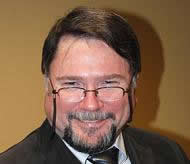
| . |
 |
| Solar
Hope Terry Drinkard |
|

|
f
you missed the BA-Meetup in London last month, you missed a
really terrific conference, or rather, 'unconference'. Truly
wonderful people, a great venue, and the sorts of presentations
that can alter your worldview in a big way. It certainly did
mine. |
|
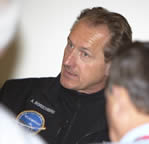 |
The
first presentation was by André
Borschberg.
André is the CEO and test pilot of the Solar Impulse project,
literally, a solar-powered heavier-than-air craft. Remember, our
industry is only 107 years old. The first three powered
heavier-than-air flights by the Wright brothers would easily fit
within the wingspan of the Solar Impulse. The first flight by
Orville was 120 feet, the second by Wilbur went 175 feet, and
the third was Orville's at 200 feet. The Solar Impulse's wing
span is 208 feet. |
Another
interesting historical parallel is that the Solar Impulse uses nothing
but sunlight to generate about the same amount of power as the Wrights
had available for their first flights. But we have learned so much since
those first days. Solar Impulse did not spring forth fully formed like
Athena from the head of Zeus. The roots of Solar Impulse lie deep within
aviation history.
Setting the Way-Back
Machine to the 17th Century
| Yes,
that's right. The 17th century; home of the Baroque cultural
movement, the English Civil War and Cyrano De Bergerac. The
dream of human-powered heavier than air flight goes back further
yet, Ancient Greek mythology tells us of Icarus and his flight's
involvement with the solar energy. The Greeks apparently had
quite a negative view of the possibilities. But the dream of
flight powered by the sun, supported by the sun, is fairly new,
by comparison.
Cyrano wrote a
novel entitled Histoire Comique des Estats et Empire de la
Lune, and Les Estats et Empire du Soleil in which the
hero gathers the morning dew in flasks tied to his belt,
harnessing what was thought to be the sun's power to raise the
dew to raise himself above the earth and fly to the moon (there
would be air to breathe all the way, he theorized). Of course,
being Cyrano, he goes in the wrong direction. It was generally
believed at the time that morning dew had a heavenly origin,
sort of 'star tears', and that it would be drawn back into the
heavens by the heat of the sun's rays. Our understanding of the
physics of dew and the structure of earth's atmosphere has
improved somewhat in the intervening four hundred years, but the
dream of solar powered flight is still with us. |
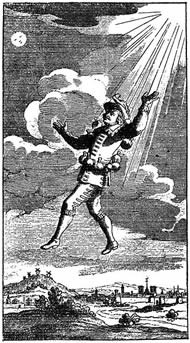 |
Dr. Paul
MacCready
Back in the
'80s when I was an undergraduate at Cal Poly, we had a number of human
powered vehicle research programs. Dr. Patterson, from my department -
aeronautical engineering - mentored two groups, including Neal
Saiki's Da Vinci
III human powered helicopter (which hovered for eight seconds at a
glorius altitude of eight inches - I was there; I saw it). I, myself,
worked on the human powered submarine (Subversion - we set the original
speed record in 1989 just off Singer Island, Florida). We thought we
were pretty good, but Dr.
Paul MacCready's
work was simply amazing. A dozen years before us, he won the Kremer
Prize (the Kremer Prize tradition continues, but now they're called
X-Prizes and Peter
Diamandis is The
Man - yes, yes, The Singularity University Peter Diamandis) for building
and flying a successful human-powered heavier than aircraft, the famous
Gossamer Condor. This is crucial technology for a solar powered
aircraft.
Pre-MacCready
| Before
MacCready was Enea
Bossi, an
Italian aeronautical engineer who emigrated to the US. Actually
Bossi studied math and physics in college, but he worked as an
aeronautical engineer. He is credited with doing some of the
preparatory work in human powered flight. He calculated that it
should be possible to fly with .94 horsepower, which is very
close to the upper limit of human |
 |
| The
Pedaliante |
| capability
(in Subversion, our primary motor guy could punch out 1.1
horsepower for a few minutes - underwater). In 1936, Bossi
designed and built the Pedaliante for an Italian human-powered
flight competition. The pilot was able to fly for 300 ft on his
own power, and after a catapult launch from 30 ft, he was able
to pedal the aircraft the full kilometer course (but did not win
the prize because a catapult launch was not allowed). |
Bossi's
design had issues, not least was the dual propellers that he thought
were required to counteract the torque that was so problematic in the
ground-based bicycle tests, and the materials he had available at the
time were heavier than what we have today. Pedaliante weighed in at 220
lbs. The Gossamer Condor weighed 70. Huge difference.
Enea Bossi
is also kind of famous for teaching Giuseppe
Bellanca (think
Bellanca Aircraft) how to fly in 1908 at the age of 20 in an airplane he
made himself. Giuseppe Bellanca taught Fiorella
LaGuardia to fly
in 1912 in an airplane he built himself - a parasol monoplane - and
learned how to fly at Mineola, Long Island, New York. LaGuardia was the
brilliant progressive mayor of New York City for a dozen years. The
airport closest to the city is named after him.
Back to
MacCready
In the '60s
and early '70s, there was quite a bit of work done in human powered
flight, but nothing could perform to the Kremer Prize rules (one mile
figure-eight course, with a ten foot high threshold at the beginning and
the end of the course). MacCready decided to form a team, which included
Dr. Peter Lissaman
the famous airfoil designer, to go after the Kremer Prize. Out of this
determination came the Gossamer Condor, which won the first Kremer Prize
in 1977. The Gossamer Albatross, also by Team MacCready, flew across the
English Channel in 1979 to capture the second Kremer Prize. The book to
read is Morton Grosser's Gossamer Odyssey.
MIT's
Project Daedalus
|
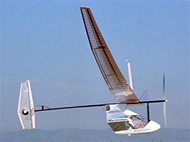
|
A
decade later, students at MIT designed and built the Daedalus
(actually, there were three, the Miller Light Eagle - MLE or
"Emily", the Daedalus 87, and the Daedalus 88) to set
human-powered flight distance records. Emily set the record for
a closed course in '87. Daedalus 88 set the FAI record for human
powered flight from Crete to the island of Santorini,
duplicating the original mythical flight of Daedalus. The book
to read is Gary Dorsey's The Fullness of Wings. |
| Daedalus
88 |
Here comes
the sun
After the
success of the Gossamer Albatross, MacCready's team took a smaller
back-up airframe and adapted it for solar power. It was dubbed the
Gossamer Penguin. This was 1980, and the Gossamer Penguin was a testbed.
It was ugly, but it worked. The follow-on aircraft, the Solar Challenger
was much better, though at a full-up weight of 200 lbs including
batteries and solar panels, it was still 10% lighter than Bossi's
Pedaliante. We have made huge strides in materials technology in those
70 years. The Solar Challenger flew the English Channel. In fact, it
flew from Paris to Manston, in the UK, 163 miles.
Two decades
after the success of Daedalus 88, the Emily was brought out of
retirement and refurbished by Aurora Flight Sciences as an unmanned
solar-powered flight testbed. Aurora Flight Sciences was founded by Dr.
John Langford,
who just happened to have been the director of Project Daedalus for MIT.
These two
programs laid the technological foundation for successful solar powered
flight.
Solar
Impulse
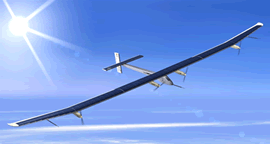 |
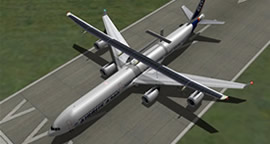 |
| Solar
Impulse has a wingspan of 208 feet |
|
|
Standing
on the shoulders of giants like Bossi, MacCready, Lissaman, and
Langford, Bertrand
Piccard,
psychiatrist/aeronaut and CEO/pilot André
Borschberg
could see new possibilities and apply the new technologies that
are continuing to emerge from the on-going materials research in
the solar power industry. This is an amazing program and an
amazing aircraft. The airplane has a wingspan of 208 ft, about
the same as a 747-400, but weighs less than one quarter of one
percent as much (to give the 747 its due, it is about 25 times
faster).
A
challenging flight
The
airplane is challenging to fly, as André Borschberg told us.
The control technique is so diferent that an autopilot had not
even been designed before the 36 hour endurance flight. That's
right. The solar powered Solar Impulse flew all day, all night,
and part of the next day. That is tremendously impressive.
The
next step
But
that's not the end. There is another airplane in the works,
HB-SIB, due to be |
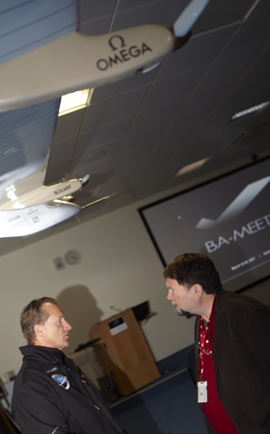 |
| Terry
Drinkard discusses the Solar Impulse project with André
Borschberg. |
completed
this year, with a wingspan the same as an A380, 262 ft. It's
mission is as impressive as its size: to fly around the world. I
hope that not only does the Solar Impulse team's success
continue, but I also hope I'm at the presentaion following their
triumphant flight.
Solar Impulse at the Paris Air Show
Solar Impulse will be making its first air show appearance as a special guest at this year's Paris Air Show, from the 20th -26th June at Le Bourget.
Visitors will be able look closely at the aircraft on the ground, and each morning - so long as weather conditions are favourable - admire its majestic flying displays.
details
|
Terry Drinkard is currently consulting on an aviation start-up. His interests and desire are being
involved in cool developments around airplanes and in the aviation industry. Usually working as
a contract heavy structures engineer, he has held positions with Boeing and Gulfstream
Aerospace and has years of experience in the MRO world. Terry’s areas of specialty are aircraft
design, development, manufacturing, maintenance, and modification; lean manufacturing;
Six-sigma; worker-directed teams; project management; organization development and
start-ups.
Terry
welcomes your comments, questions or feedback. You may contact him via terry.drinkard@blueskynews.aero
Other
recent articles by Terry Drinkard:
| ©BlueSky
Business Aviation News | 14th April 2011 | Issue #121 |
| . |
 |
| BlueSky
- your weekly business and executive aviation news - every
Thursday |
| . |
 |
|







